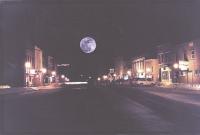
Serving the Vermont Champlain Valley Area for 45 Years
Main SectionsFront Page SportsValley VitalsIt's in the StarsStarwiseArchivesLinksAbout The VoiceContact Us |
Where is Pocock Vermont?
Tuesday May 13, 2008 By M. Stuart Parks Fourteen years before the American Revolution, in 1762, The town of Pocock, Vermont was granted to Samuel Avery and sixty two of his associates for about 20 English pounds each. Although New York claimed the land that is now Vermont, New Hampshire Governor Benning Wentworth, an agent of King George the Third, granted or sold townships in Vermont to men who saw an opportunity to settle new land and to sell or lease that land to others. At about the same time Admiral George Pocock, in command of the British fleet, had wrested Havana, Cuba from the Spanish and was in need of a reward. Along with a knighthood and 122,000 British pounds, a new town was named after him. Like most Vermont towns it covered approximately 23,600 acres and had areas set aside as public lands for schools and worship. In the far northeast corner was a large lot known as the “Governor's Right”, which was four or more times the size of the standard division. Pocock sat virtually empty for 24 years until the first permanent settlement in the summer of 1786. It was then that June Samuel Stewart and Eden Johnson and their wives and children came to settle here. One of the men drove their cattle overland while the other brought the wives and children up Lake Champlain. Other families soon followed. In October of 1789 the Vermont Legislature changed the name of the town to Bristol which some historians believe was after the town of Bristol, Rhode Island. By 1800 the town had really begun to grow and a grist mill and a sawmill were built. Since there was iron ore in the area there was soon a forge which was a great use to Bristol and other towns. Over the next 50 years there were six forges in Bristol, one owned by Winter H. Holley. The first post office was established in 1803 and the townspeople took turns bringing the mail from Middlebury. By 1840 the population of Bristol was 1,233 and there were numerous business enterprises. Along with three mercantile stores there was a shoemaker, a harness shop, a blacksmith's shop and wagon shops. The Bristol House Hotel was kept by Samuel Eddy. During the second half of the 1800s more businesses flourished: Bristol Manufacturing made coffins and caskets; J.H. Wright was a carriage maker; W.H. Miller dealt in clothing nd furnishings; F.I. Ward sold millinery and fancy goods; E.S. and S.D. Farr sold stoves and hardware and J.J. Dumas sold sash, doors and blinds. The S.W. Hatch enterprise offered furniture, carpets and undertaking service. There were als drug stores, cigar makers, grocery stores, a photograph gallery, dry goods, boots and shoes and a merchant tailor. A local newspaper, the Bristol Herald, was established in 1879 by the Wilson brothers. By 1840 there were four churches in Bristol: The Bristol Baptist (est. 1794), the Congregational (est. 1805), the Methodist (est. 1813) and the Advent Christian which held services as early as 1840. A Masonic Lodge was chartered in 1859. Bristol has no Revolutionary War history because it was not settled at the time but in June of 1791 the Tenth Company, Second Regiment, Sixth Brigade Vermont Infantry was organized here under the leadership of Cyprian Eastman. In 1808, another Company, the Light Infantry, was organized and John Hilborn was elected captain. In 1814 sixty-six Bristol volunteers were present at the invasion of Plattsburgh. During the Civil War approximately 115 men from Bristol served in Vermont Regiments. Few young men were not volunteers. Next week's edition will continue the story of Bristol on the present day.
|
AdvertisementsSearch our Archives |
Agricultural Weather Forecast:

© 2006-18 The Valley Voice • 656 Exchange St., Middlebury, VT 05753 • 802-388-6366 • 802-388-6368 (fax)
Valleywides: [email protected] • Classifieds: [email protected] • Info: [email protected]

 Printer Friendly
Printer Friendly